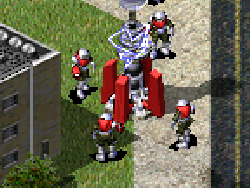

These capacitors consisted of plates in oil that were movable. The capacitors were of a special design, small with high insulation. The discharge tips were usually metal balls under one inch (25 mm) in diameter, though Tesla used various forms of dischargers. A spark gap is placed in parallel to the Ruhmkorff coil before the capacitors. The Ruhmkorff coil, being fed from a main source, is wired to capacitors on both ends in series. The setup can be duplicated by a Ruhmkorff coil, two condensers (now called capacitors), and a second, specially constructed, disruptive coil. These early coils used a disruptive discharge across a spark gap in their operation. Following the initial research of voltage and frequency by William Crookes, Tesla designed and constructed a series of coils that produced high- voltage, high-frequency currents. In the spring of 1891, Tesla gave demonstrations with various machines before the American Institute of Electrical Engineers at Columbia College. 6 B (13.3 mm²) & S wire, and the whole combination immersed in a vessel containing linseed or mineral oil.


Into this is slipped a primary consisting of eight to ten turns of AWG No. The Serbian Electrician gives a description of an early tesla coil wherein a glass battery jar, six by eight inches (15×20 cm), is wound with 60 to 80 turns of AWG No. Today they are built by many high-voltage enthusiasts. The later Tesla coil designs can also be used to create long electrical discharges. An important characteristic of his later, higher power coil designs was that the primary and secondary circuits were also tuned so that they resonated at the same (high) frequency (typically, but not always, between 25 kHz and 2 MHz). Tesla's early and later designs usually employed a high voltage power source, one or more high voltage capacitor(s), and a spark gap to excite the primary side of the Tesla Coil with periodic bursts of high frequency current. The designs of his "early coils" and "later coils" were considerably different. Tesla used these coils to conduct innovative experiments in electrical lighting, fluorescence, x-rays, high frequency alternating current phenomena, electrotherapy, and wireless power for electric power transmission. Tesla experimented with a large variety of coils and configurations, so it is difficult to define a " Tesla coil" as one specific mode of construction. Tesla coils consist of two, or sometimes three, coupled resonant electric circuits. A Tesla coil (also teslacoil) is a type of resonant transformer, named after its inventor, Nikola Tesla.


 0 kommentar(er)
0 kommentar(er)
